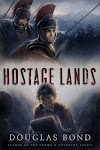 |
| Gargoyle straining under the weight of the world |
SYMBOLS
I led off reading a paragraph from Rosemary Sutcliff's Shield Ring, which I just finished reading with my daughter Gillian this evening before 'Blots (while she worked on her CC science project spread all over the living room; multiple reads over the years with the bigs). Sutcliff deftly elevated a ring on Bjorn's finger to the level of a symbol, a collector of meaning, a tangible connector to his past, a symbol of his heritage, of his Saxon ethnicity, of his identity and place in the new Viking world that he now lived in, now imminently under the threat of being crushed by Norman invaders (Reformation France/Armistice 100 Tour will be visiting William the Conqueror's birthplace in charming Bayeux and the Medieval tapestry, and where he is buried in Caen at Abby des homes--a few spaces still open, but not for long).
WRITING AND SUFFERING
Sidney will lead off with a portion of a novel she is writing, a passage that is informed in part by the death of her brother Isaiah the day before Thanksgiving. It is emotional and personal. This is clearly white-hot out of suffering and the immediate experience of loss and grief. But very much in control. there's no blubbering here (though there is absolutely nothing wrong with blubbering in our grief), no exploiting, only writing what she needs, as Lewis urges all writers to do, "Write what you need." Sidney is doing so brilliantly. There are so many rich uses of words here: Silent whisper of life; low moan, rattling of the throat, hastened footsteps (this reminds me of Lewis's description in Surprised by Joy of the night his mother died when he was nine); candles, their wax frozen mid drip; kiss of a ghost; silently giving up his soul to the blackness; a tender reed upon which life had trampled, and much more.
This passage demonstrates the power of fiction. Sidney could write this as a non-fiction blog post (I've been reading her posts, and she has done so, very ably, with maturity beyond her years), but here there is a transcendence as if we the reader are looking from on high at the tragic and dramatic scene, and at the same time we are transported into the hospital room, the sights, sounds, smells (I think you could give us more of the smells), the wailing, the painful intake of breath. It is so painfully real, I am torn. I want to be there, and yet I want to run away (you want to be careful in an opening chapter to not be so weighty that your reader feels they need to run away or be crushed). The word painting is incomparably wonderful. But none of us are perfect. I have a few suggestions. Help readers have a clearer sense of from whose eyes we are seeing the world through. Mostly it is the boy, but then it seems to shift to the woman, the mother, who appears to take her own life, to the anguish of her son. Some of Sydney's description dangles, is not tightly connected to and affecting the protagonist. And there needs to be greater clarity on who, the protagonist actually is. I lost the thread of the boy's point of view. It may be in part your use of Time personified in the feminine and hence the shift to "She" pronouns. Compound that with the She pronoun for the mother. Clarify pronouns. "I hate and mistrust pronouns, every one of them as slippery as a fly-by-night personal-injury lawyer." Stephen King, On Writing
Patrick commented that there is a problem of whose world we are seeing things from, and, I'm interpreting him, maybe it is overly dense for a first chapter. I agree on a certain level. I think Sidney gives us too much in the opening chapter; it is lengthy for a first chapter, probably too lengthy. For a nine year old, the boy has intensely mature perspective and processes the action going on around him like an adult. I'd suggest giving the nine-year-old a legitimately mature vantage point on what is going on by making it clear that he is looking back on it all from an older perspective. Leave some of the backstory for a later chapter. You don't have to cover it all in the opening chapter, in fact, it is best not to do so. Maybe mapping it out would be helpful at this stage. Where are you going, at least in broad strokes. This will give more direction and clarity to how you use your artist brush in each chapter and episode.
I interviewed a young writer on my podcast The Scriptorium the other day and cautioned her that being a writer meant being a sufferer. Suffering is not a smorgasbord. There's no menu with lots of options. We don't get to request the particular flavor of suffering we would like, or how we would like it cooked. God chooses for us. He is sovereign over suffering, over all things; he is all-wise in the exercise of his sovereignty, and he is motivated purely by love for his children. Hence, "What ere my God ordains is right." Sidney, who is passing through some very deep waters, is writing what she needs in her suffering, as so richly illustrated in this passage she shared with us this eveing. Wonderful writing!
SHOW DON'T TELL
Patrick read next, his sci-fi futuristic yarn. Welcome to Mars. I love it. familiar hiss, I think that needs more work; maybe a simile or metaphor for the hiss, one that relates to and further intensifies the Mars context. Patrick does a fine job of keeping the action and pace moving forward. It's clearly his strength. But there's some work to do on showing rather than telling, creating depth and breadth to the narrative as it moves forward. For example, he writes, "The idea thrilled him." Could you show his thrill, his reaction, hastening of his pulse, sharp intake of breath, or better. Let the reader read what you have shown and say "he is thrilled." Another example, "Cloudless sky." Could you describe the color of the sky over Mars, with a comparison to a vintage car color, or?
"But first he had to introduce himself." You don't need to announce things like this. It's far more effective to do it, than to tell us you're going to do it, then do it. You could nuance this by showing body language that shows he forgets basic human relational interactions; silly me. Or the woman he needs to introduce could say something that jolts him into introducing her. I would also like to hear more dialogue. Patrick has lots of narrative sequential description, but it feels static. I feel like I am seeing a series of still photographs, with changes between shots, but not smoothly connected like the minute and fluid movements of a movie camera. As to introductions, when you do have them near the end of your reading with Joanna, it feels stilted, unnecessary to maintaining the pace. "Defiantly," avoid adding adverbs to attributions (Stephen King says that the road to hell is paved with adverbs). Show defiance in the words themselves, his posture, or tone, or a gesture.
We talked about the length of speculative fiction short stories, "short" is fairly long in this genre (9,000 words). How to create episodes and natural pauses without chapter breaks?
Where did the two hours go? Great to be back together with Inkblots. See you in a couple of weeks. Check out my new and improved (improving) web page bondbooks.net. Thanks to the amazing work of my summer marketing intern Sionna Spears.
Douglas Bond, author of more than twenty-five books, is husband of Cheryl, father of six, and grandfather of four. He is Director for the Oxford Creative Writing Master Class, two-time Grace Award book finalist, adjunct instructor in Church history, advisory member to the national committee for Reformed University Fellowship, award-winning teacher, hymn writer, speaker at conferences, and leader of Church history tours in Europe. He broadcasts weekly at The Scriptorium. Follow him here and at bondbooks.net



























No comments:
Post a Comment